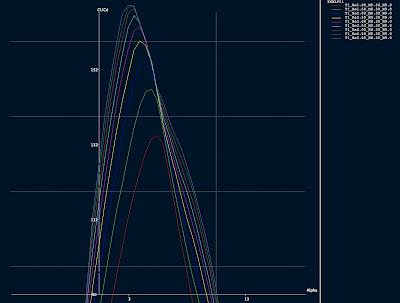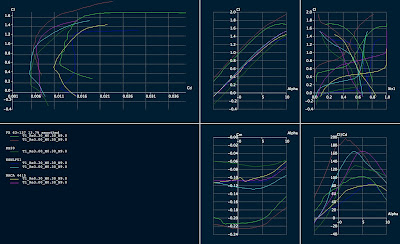Airfoil KSNLF51:

KSNLF51 L/D graph:

Data file: http://www.katix.org/karoliina/airfoils/KSNLF51.DAT
Polars:
Re 1 million, Mach 0.3
http://www.katix.org/karoliina/airfoils/KSNLF51_T1_Re1.00_M0.30_N9.0.txt
Re 3 millions, Mach 0.3
http://www.katix.org/karoliina/airfoils/KSNLF51_T1_Re3.00_M0.30_N9.0.txt
Re 5 millions, Mach 0.3
http://www.katix.org/karoliina/airfoils/KSNLF51_T1_Re5.00_M0.30_N9.0.txt
License: Creative Commons Share-a-like
Comparison between some airfoils:

3 comments:
I always thought low-Re airfoils had to have small leading edge radii and be fairly thin to not have separation problems -- yours is wonderfully rounded and thick. How did you arrive at that design? I'm amazed at the low pitching moment too, with the cusp at the TE I would have thought it would substantially greater than that.
The simulators don't lie, though -- I've just got to do some more experimentation.
Nevermind :) I do all of my airfoil analysis for model airplanes, and low Re to me is more like 1e5 not 1e6, and the rules are totally different at those Reynolds numbers. Check out the MH64 airfoil at
http://www.mh-aerotools.de/airfoils/index.htm
for example.
It is not really ideal for really low Re, my low Re basically means here wing tip of tapered wing of full size aircraft at stall speed. Just calculated yesterday that the Re can get as low as 500000.
Post a Comment